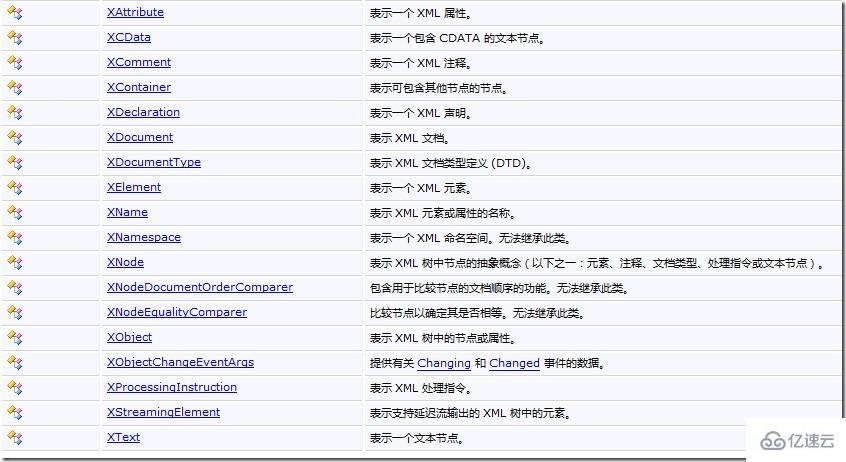这篇文章给大家分享的是有关如何使用LINQ to XML创建xml的内容。小编觉得挺实用的,因此分享给大家做个参考,一起跟随小编过来看看吧。

以下的代码演示了如何使用LINQ to XML来快速创建一个xml:
public static void CreateDocument()
{
string path = @"d:\website";
XDocument xdoc = new XDocument(new XDeclaration("1.0", "utf-8", "yes"),
new XElement("Root", "root"));
xdoc.Save(path);
}运行该示例将会得到一个xml文件,其内容为:
<?xml version="1.0" encoding="utf-8" standalone="yes"?> <Root>root</Root>
XElement 类是 LINQ to XML 中的基础类之一。 它表示一个 XML 元素。 可以使用该类创建元素;更改元素内容;添加、更改或删除子元素;向元素中添加属性;或以文本格式序列化元素内容。 还可以与 System.Xml 中的其他类(例如 XmlReader、XmlWriter 和 XslCompiledTransform)进行互操作。
使用LINQ to XML创建xml文档有很多种方式,具体使用哪种方法要根据实际需要。而创建xml文档最简单、最常见的方式是使用XElement类。以下的代码演示了如何使用XElement类创建一个xml文档:
这是一段程序代码。
public static void CreateCategories()
{
string path = @"d:\website";
XElement root = new XElement("Categories",
new XElement("Category",
new XElement("CategoryID", Guid.NewGuid()),
new XElement("CategoryName", "Beverages")
),
new XElement("Category",
new XElement("CategoryID", Guid.NewGuid()),
new XElement("CategoryName", "Condiments")
),
new XElement("Category",
new XElement("CategoryID", Guid.NewGuid()),
new XElement("CategoryName", "Confections")
)
);
root.Save(path);
}运行该示例将会得到一个xml文件,其内容为:
<?xml version="1.0" encoding="utf-8"?> <Categories> <Category> <CategoryID>57485174-46fc-4e8c-8d98-d25b53d504a1</CategoryID> <CategoryName>Beverages</CategoryName> </Category> <Category> <CategoryID>1474dde1-8014-48f7-b093-b47ca5d5b770</CategoryID> <CategoryName>Condiments</CategoryName> </Category> <Category> <CategoryID>364224e0-e002-4939-90fc-0fd93e0cf35b</CategoryID> <CategoryName>Confections</CategoryName> </Category> </Categories>
XElement类包含了许多方法,这些方法使得处理xml变得轻而易举。有关这些方法请参照MSDN。
其中,Save、CreateReader、ToString和WriteTo方法是比较常用的三个方法:

XAttribute类用来处理元素的属性,属性是与元素相关联的“名称-值”对,每个元素中不能有名称重复的属性。使用XAttribute类与使用XElement类的操作十分相似,下面的示例演示了如何在创建xml树时为其添加一个属性:
public static XElement CreateCategoriesByXAttribute()
{
XElement root = new XElement("Categories",
new XElement("Category",
new XAttribute("CategoryID", Guid.NewGuid()),
new XElement("CategoryName", "Beverages")
),
new XElement("Category",
new XAttribute("CategoryID", Guid.NewGuid()),
new XElement("CategoryName", "Condiments")
),
new XElement("Category",
new XAttribute("CategoryID", Guid.NewGuid()),
new XElement("CategoryName", "Confections")
)
);
root.Save(path);
return root;
}运行该示例将会得到一个xml文件,其内容为:
<?xml version="1.0" encoding="utf-8"?> <Categories> <Category CategoryID="a6d5ef04-3f83-4e00-aeaf-52444add7570"> <CategoryName>Beverages</CategoryName> </Category> <Category CategoryID="67a168d5-6b22-4d82-9bd4-67bec88c2ccb"> <CategoryName>Condiments</CategoryName> </Category> <Category CategoryID="17398f4e-5ef1-48da-8a72-1c54371b8e76"> <CategoryName>Confections</CategoryName> </Category> </Categories>
XAttribute类的方法比较少,常用的三个是:

以下的示例使用Remove来删除第一个元素的CategoryID属性:
public static void RemoveAttribute()
{
XElement xdoc = CreateCategoriesByXAttribute();
XAttribute xattr = xdoc.Element("Category").Attribute("CategoryID");
xattr.Remove();
xdoc.Save(path);
}运行该示例将会得到一个xml文件,其内容为:
<?xml version="1.0" encoding="utf-8"?> <Categories> <Category> <CategoryName>Beverages</CategoryName> </Category> <Category CategoryID="5c311c1e-ede5-41e5-93f7-5d8b1d7a0346"> <CategoryName>Condiments</CategoryName> </Category> <Category CategoryID="bfde8db5-df84-4415-b297-cd04d8db9712"> <CategoryName>Confections</CategoryName> </Category> </Categories>
作为尝试,试一试以下删除属性的方法:
public static void RemoveAttributeByDoc()
{
XElement xdoc = CreateCategoriesByXAttribute();
XAttribute xattr = xdoc.Attribute("CategoryID");
xattr.Remove();
xdoc.Save(path);
}运行该示例将会抛出一个空引用异常,因为元素Categories没有一个叫做CategoryID的属性。
XDocument类提供了处理xml文档的方法,包括声明、注释和处理指令。一个XDocument对象可以包含以下内容:

下面的示例创建了一个简单的xml文档,它包含几个元素和一个属性,以及一个处理指令和一些注释:
public static void CreateXDocument()
{
XDocument xdoc = new XDocument(
new XProcessingInstruction("xml-stylesheet", "title='EmpInfo'"),
new XComment("some comments"),
new XElement("Root",
new XElement("Employees",
new XElement("Employee",
new XAttribute("id", "1"),
new XElement("Name", "Scott Klein"),
new XElement("Title", "Geek"),
new XElement("HireDate", "02/05/2007"),
new XElement("Gender", "M")
)
)
),
new XComment("more comments")
);
xdoc.Save(path);
}运行该示例将会得到一个xml文件,其内容为:
<?xml version="1.0" encoding="utf-8"?> <?xml-stylesheet title='EmpInfo'?> <!--some comments--> <Root> <Employees> <Employee id="1"> <Name>Scott Klein</Name> <Title>Geek</Title> <HireDate>02/05/2007</HireDate> <Gender>M</Gender> </Employee> </Employees> </Root> <!--more comments-->
XDocument类包含多个与XElement类相同的方法,具体内容可以参阅MSDN。需要注意的是,处理节点和元素的大部分功能都可以通过XElement获得,只有当绝对需要文档层次的处理能力,以及需要访问注释、处理指令和声明时,才有使用XDocument类的必要。
创建了xml文档后,可以使用NodesAfterSelf方法返回指定的XElement元素之后的所有同级元素。需要注意的是,此方法只包括返回集合中的同级元素,而不包括子代。此方法使用延迟执行。以下代码演示了这一过程:
public static void NodesAfterSelf()
{
XElement root = new XElement("Categories",
new XElement("Category",
new XElement("CategoryID", Guid.NewGuid()),
new XElement("CategoryName", "食品"),
new XElement("Description", "可以吃的东西")
)
);
foreach (var item in root.Element("Category").Element("CategoryID").NodesAfterSelf())
{
Console.WriteLine((item as XElement).Value);
}
}本节将介绍LINQ to XML编程的相关概念,例如如何加载xml、创建全新xml、操纵xml的信息以及遍历xml文档。
使用LINQ to XML加载xml可以从多种数据源获得,例如字符串、XmlReader、TextReader或文件。
下面的示例演示了如何从文件中加载xml:
public static void LoadFromFile()
{
XElement root = XElement.Load(path);
Console.WriteLi也可以使用Parse方法从一个字符串加载xml:
public static void LoadFromString()
{
XElement root = XElement.Parse(@"
<Categories>
<Category>
<CategoryID>1</CategoryID>
<CategoryName>Beverages</CategoryName>
<Description>Soft drinks, coffees, teas, beers, and ales</Description>
</Category>
</Categories>
");
Console.WriteLine(root.ToString());
}在前面的示例中曾多次调用XElement对象的Save方法来保存xml文档,在这里就不冗述了。
在前面的示例中曾多次调用XElement对象的构造函数来创建xml文档,在这里就不冗述了。需要说明的是,在使用LINQ to XML创建xml文档时,会有代码缩进,这使代码的可读性大大加强。
使用LINQ to XML在xml树中遍历xml是相当简单的。只需要使用XElement和XAttribute类中所提供的方法。Elements和Element方法提供了定位到某个或某些元素的方式。下面的示例演示了如何遍历xml树,并获取指定元素的方式:
public static void Enum()
{
XElement root = new XElement("Categories");
using (NorthwindDataContext db = new NorthwindDataContext())
{
root.Add(
db.Categories
.Select
(
c => new XElement
(
"Category"
, new XElement("CategoryName", c.CategoryName)
)
)
);
}
foreach (var item in root.Elements("Category"))
{
Console.WriteLine(item.Element("CategoryName").Value);
}
}上述代码运行的结果为:

是不是很简单呢?Nodes()、Elements()、Element(name)和Elements(name)方法为xml树的导航提供了基本功能。
LINQ to XML一个重要的特性是能够方便地修改xml树,如添加、删除、更新和复制xml文档的内容。
I.插入
使用XNode类的插入方法可以方便地向xml树添加内容:

在下面的示例中,使用AddAfterSelf方法向现有xml中添加一个新节点:
public static void AddAfterSelf()
{
XElement root = XElement.Parse(@"
<Categories>
<Category>
<CategoryID>1</CategoryID>
<CategoryName>Beverages</CategoryName>
<Description>Soft drinks, coffees, teas, beers, and ales</Description>
</Category>
</Categories>
");
XElement xele = root.Element("Category").Element("CategoryName");
xele.AddAfterSelf(new XElement("AddDate", DateTime.Now));
root.Save(path);
}运行该示例将会得到一个xml文件,其内容为:
<?xml version="1.0" encoding="utf-8"?> <Categories> <Category> <CategoryID>1</CategoryID> <CategoryName>Beverages</CategoryName> <AddDate>2010-01-31T03:08:51.813736+08:00</AddDate> <Description>Soft drinks, coffees, teas, beers, and ales</Description> </Category> </Categories>
当需要添加一个元素到指定节点之前时,可以使用AddBeforeSelf方法。
II.更新
在LINQ to XML中更新xml内容可以使用以下几种方法:

在下面的示例中使用了ReplaceWith与SetElementValue方法对xml进行了更新操作:
public static void Update()
{
XElement root = XElement.Parse(@"
<Categories>
<Category>
<CategoryID>1</CategoryID>
<CategoryName>Beverages</CategoryName>
<Description>Soft drinks, coffees, teas, beers, and ales</Description>
</Category>
</Categories>
");
root.Element("Category").Element("CategoryID").ReplaceWith(new XElement("ID", "2"));
root.Element("Category").SetElementValue("CategoryName", "test data");
root.Save(path);
}运行该示例将会得到一个xml文件,其内容为:
<?xml version="1.0" encoding="utf-8"?> <Categories> <Category> <ID>2</ID> <CategoryName>test data</CategoryName> <Description>Soft drinks, coffees, teas, beers, and ales</Description> </Category> </Categories>
III.删除
可以使用Remove(XElement)与RemoveAll方法来删除xml。
在下面的示例中,使用了RemoveAll方法:
}
public static void Remove()
{
string path = @"d:\";
XElement root = XElement.Parse(@"
<Categories>
<Category>
<CategoryID>1</CategoryID>
<CategoryName>Beverages</CategoryName>
<Description>Soft drinks, coffees, teas, beers, and ales</Description>
</Category>
</Categories>
");
root.RemoveAll();
root.Save(path);
}运行该示例将会得到一个xml文件,其内容为:
<?xml version="1.0" encoding="utf-8"?> <Categories />
在下面的示例中,使用了Remove方法删除了xml的Description元素:
public static void Remove()
{
XElement root = XElement.Parse(@"
<Categories>
<Category>
<CategoryID>1</CategoryID>
<CategoryName>Beverages</CategoryName>
<Description>Soft drinks, coffees, teas, beers, and ales</Description>
</Category>
</Categories>
");
root.Element("Category").Element("Description").Remove();
root.Save(path);
}运行该示例将会得到一个xml文件,其内容为:
<?xml version="1.0" encoding="utf-8"?> <Categories> <Category> <CategoryID>1</CategoryID> <CategoryName>Beverages</CategoryName> </Category> </Categories>
I.添加
LINQ to XML添加属性与添加元素师类似的,可以使用构造函数或者Add方法来添加属性:
public static void AddAttribute()
{
XElement root = new XElement("Categories",
new XElement("Category",
new XAttribute("CategoryID", "1"),
new XElement("CategoryName", "Beverages"),
new XElement("Description", "Soft drinks, coffees, teas, beers, and ales")
)
);
root.Element("Category").Add(new XAttribute("AddDate", DateTime.Now.ToShortDateString()));
root.Save(path);
}运行该示例将会得到一个xml文件,其内容为:
<?xml version="1.0" encoding="utf-8"?> <Categories> <Category CategoryID="1" AddDate="2010-01-31"> <CategoryName>Beverages</CategoryName> <Description>Soft drinks, coffees, teas, beers, and ales</Description> </Category> </Categories>
II.检索
检索属性可以使用Attribute(name)方法:
public static void SelectAttribute()
{
XElement root = new XElement("Categories",
new XElement("Category",
new XAttribute("CategoryID", "1"),
new XElement("CategoryName", "Beverages"),
new XElement("Description", "Soft drinks, coffees, teas, beers, and ales")
)
);
XAttribute xattr = root.Element("Category").Attribute("CategoryID");
Console.WriteLine(xattr.Name);
Console.WriteLine(xattr.Value);
}上述代码的运行结果为:
CategoryID 1
感谢各位的阅读!关于“如何使用LINQ to XML创建xml”这篇文章就分享到这里了,希望以上内容可以对大家有一定的帮助,让大家可以学到更多知识,如果觉得文章不错,可以把它分享出去让更多的人看到吧!
免责声明:本站发布的内容(图片、视频和文字)以原创、转载和分享为主,文章观点不代表本网站立场,如果涉及侵权请联系站长邮箱:is@yisu.com进行举报,并提供相关证据,一经查实,将立刻删除涉嫌侵权内容。